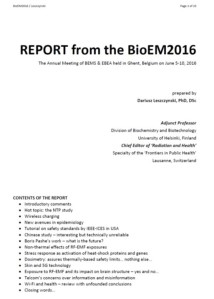The 23-pages Report from the BioEM2016 is available (BIOEM2016_Report _DL_Final).
From the Introduction and Contents:
BioEM2016 conference took place on June 6 -10, 2016 in Ghent, Belgium. Seen here is the view of the conference site, Het Pand, the large building on the left on the Leie River, a former monastery.
This report has been prepared for the Pandora Foundation, Germany, and Competence Initiative, Germany, which supported travel and participation of the author in BioEM2016. Parts of this report were published during the course of the BioEM2016 as blogs on “BRHP – Between a Rock and a Hard Place” site.
Only several topics presented at the BioEM2016 are presented and discussed in this report. For the full list of topics presented at the BioEM2015, please, consult the freely available program book. However, the book of extended conference abstracts is accessible only for the registered participants of the BioEM2015, and for the members, in good standing, of the BEMS and EBEA.
The content list of the report:
- Introductory comments
- Hot topic: the NTP study
- Wireless charging
- New avenues in epidemiology
- Tutorial on safety standards by IEEE-ICES in USA
- Chinese study – interesting but technically unreliable
- Boris Pashe’s work – what is the future?
- Non-thermal effects of RF-EMF exposures
- Stress response as activation of heat-shock proteins and genes
- Dosimetry: assures thermally-based safety limits… nothing else…
- Skin and 5G technology
- Exposure to RF-EMF and its impact on brain structure – yes and no…
- Telcom’s concerns over information and misinformation
- Wi-Fi and health – review with unfounded conclusions
- Closing words…

Pingback: BioEM2017 – just a routine, no exciting studies and no breakthrough studies | BRHP – Between a Rock and a Hard Place
Pingback: NTP-study presentation at the BioEM2016 | BRHP – Between a Rock and a Hard Place
Reblogged this on Grossesse Québec.
You wrote: “carcinogenic, likely only to some selected group of more sensitive persons “. This seems a hypothesis which is possible but difficult to verify and, at the current state of knowledge, its relevance is not clear to me. Some papers such as Hardell and Szmigielski estimate excess risk ratios of cancer resulting from exposure to radio radiation. The personal risk, IF your hypothesis is correct, is a function of a-priory personal sensitivity and of a probability of a person with this sensitivity to get cancer. Since, for now, nobody knows his personal sensitivity all that matters to a person expecting a strong exposure to radiation is the excess risk ratio. In the distant future, if it would be possible to identify a-priory personal sensitivity to cancer by RF radiation this would become an interesting issue.
One discussion that is usually missing from any exposure discussions is the effects Near field radiation where spectacular peaks and valleys of radiation con occur. The generally accepted multiplier of the power density in the near field is 4 times – actually one should never use most RF meters to measure in the near field (around a laprtop 1 +metres) the meters usually only measure electric field and calculate the rest assuming the far field 377 ohms impedance in free space applies
I do agree with Vijay on the stated ‘hormesis’ phenomenon that is actually not hormesis in the Chinese study. Boris’ experiments… I agree as well; The Ghent abstract just counted peas, and I do not see real arguments (missed that talk though); Michael Wyde showed some new results that are not mentioned in the published report / paper; and yes, HSPs are not only activated by temperature; it is not that simple;
Thank you.